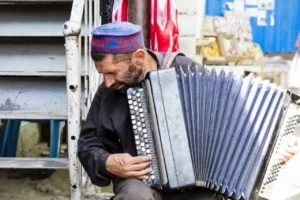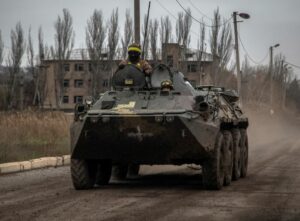Out of a Movie: Travel Tips for Morocco’s ‘Film Capital’ Ouarzazate

Atlas Studios, Cinema Museum, and Ait Ben Haddou offer cinephiles the perfect destinations for exploring movie sets and learning about Morocco’s role in the filmmaking world.
Many have fantasized life as a movie character, globetrotting through breathtaking landscapes — or even historical eras — in the span of mere hours. This dream comes true in Morocco’s Ouarzazate, the perfect destination for cinephiles with its studio, museum and natural beauty.
So let’s embark, and remember to pack a camera.
Atlas Studios
As the largest movie studio in the world, Atlas Studios boasts high-profile productions including “The Mummy” (1999), “Gladiator” (2000), and “Kingdom of Heaven” (2005).
The grandest set, perhaps, belongs to “Cleopatra” (1999). For indoor scenes, gilded pillars line a seemingly endless hall, with sunlight spilling in such that the ancient Egyptian-style paintings shine while dark corners remain tauntingly hooded — much like the mysterious glamor of Queen Cleopatra VII Philopator herself. The outdoor court is no less breathtaking, with regal sphinxes painted with vivid blues and reds.
There, my friend snapped a photo and told her family that she’d traveled to Egypt. They promptly believed her.
Many sets are multi-purpose: A prison for gladiators also served as a tavern for vikings in a different film. A pillory — long wooden plank with holes — that trapped slaves by their necks was also used to serve mead to warriors, our guide said.
One minute we were traversing eerie Egyptian catacombs, the next minute we entered an ancient Roman village. Despite knowing that the sets are but a facade made of wood and plaster, their sheer geographic diversity, from buddhist Tibet to various American military vehicles used for desert-based action films, dazzled.

The author at Atlas Studios. Photo by Nada Bouahned.
Cinema Museum
Unlike the busy, tourist-swarmed Atlas Studios — with a MAD 80 ($8) entrance fee — the Cinema Museum is a non-assuming hidden gem tucked away opposite the Tourirt Kasbah that charges only MAD 30 ($3) or MAD 15 ($1.5) for students.
“Museum” is perhaps a misnomer, because there is virtually no display case or plaque except for a room of old equipment and costumes. Rather, the museum is a maze of old movie sets preserved in perfect condition, a large percentage of which seem to have been built for films on Abrahamic religions.
Read Also: The City of Ouarzazate, Morocco: Africa’s Hollywood
With no guide rushing visitors along and few other tourists around, we had all the time we wanted to take creative photos in each setting. For an artsy aesthetic, we strolled through ancient Greek courtyards and lounged about on Mesopotamian thrones. For bolder shots, we dangled from chains in a torture chamber or and glowered from behind bars of a barren prison.
In all, the museum is an underrated treasure cove that I would recommend above the studio.

Entrance to the Cinema Museum. Photo by Selina Chen.
Ait Ben Haddou
Located a half-hour drive from Ouarzazate — that’s MAD 15 ($1.5) per person on a big taxi — Ait Ben Haddou is ksar (fortified village) and a UNESCO World Heritage Site for its authentic preservation of Moroccan earthen architecture.
The village’s beauty did not go unnoticed by the cinema world, as significant works from “Lawrence of Arabia” (1962) to the TV series “Game of Thrones” took scenes from there.
The narrow roads, lined with crafts for sale, are packed with tourists. Against the instinct to follow the crowd, we stepped off the beaten path into the inconspicuous alleys — they led us to the most breathtaking sights of Ait Ben Haddou’s reddish, unyielding structures.
I visited earlier this month, as the Gladiator II crew was gearing up for filming to begin in May. In a fenced-off area by Ait Ben Haddou, I got a sneak peak of wooden scaffolds arranged in a circle — clearly meant to be the foundation of gladiators’ arena.

Ait Ben Haddou. Photo by Selina Chen.
The locals
There’s so much more to Ouarzazate than the three sites described above, so I wouldn’t recommend a day-trip from Marrakech — a common tourists’ choice — because eight hours of exhausting transportation depletes valuable time.
Rather, stay the night and explore the city beyond its — somewhat artificial, if I may be frank — tourist attractions. Buy some dates and rose water, the local specialties. Dine in the medina (old city) square and gaze at the joyous scene of children zooming about in neon-light toy cars and teens dancing in slow-moving circles.
Movie nerds should consider talking to the locals about their lives in the “film capital of Morocco.”
Abdel Aziz of Ait Ben Haddou, for example, has been in ten movies because filmmakers cast lots of locals as extras, he told Morocco World News. He explained that the bustling tourism continues as usual during filming, so many tourists have had the chance to meet and take photos with the stars.
The Polydisciplinary Faculty of Ibn Zohr University is another example of Ouarzazate’s crucial role in the entertainment industry. Students study all aspects of cinema, especially the technical part such as camerawork, lighting, or set-building. The faculty boasts a close relationship with the movie studios: Students take practical exams there and meet the actors and directors for further learning. Many alumni have since made a name for themselves in the cinema world, the door guard told Morocco World News.
As I departed after three nights there, Ouarzazate’s gentle morning breeze bid me farewell against a background of snow-capped Atlas mountains and rising desert sun.

Source : Morocco World News





